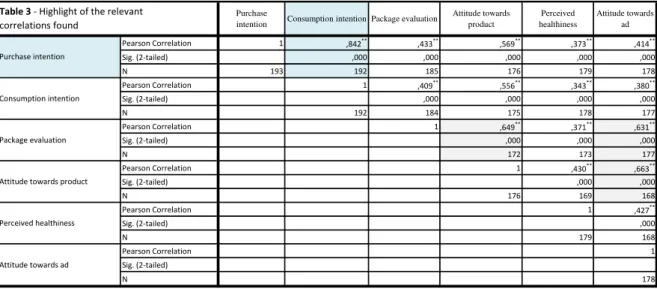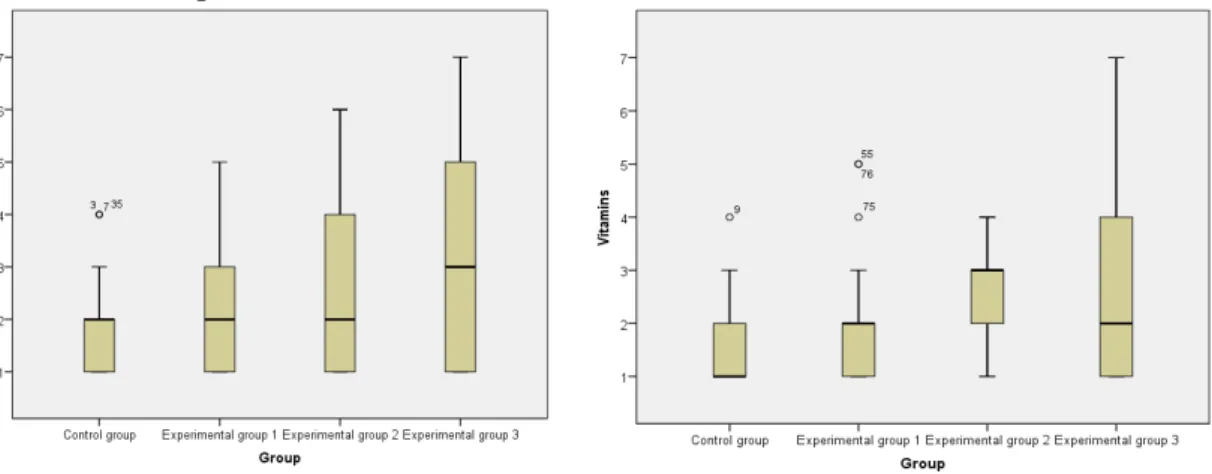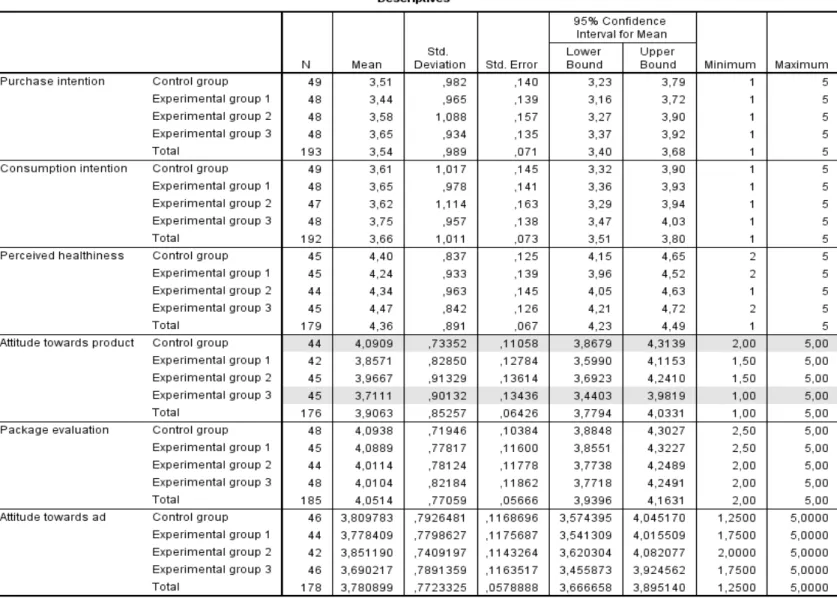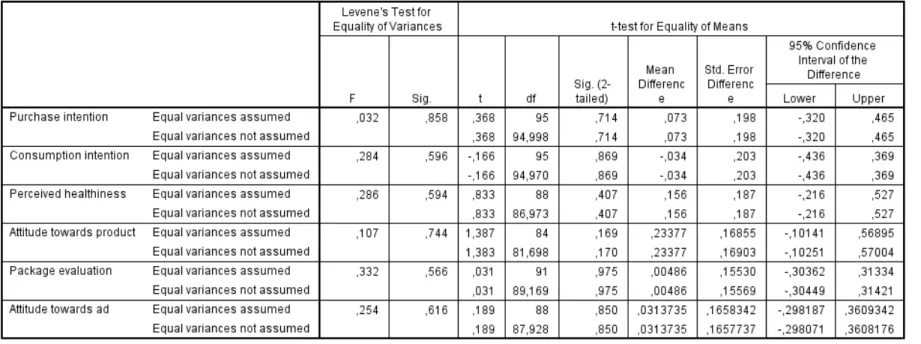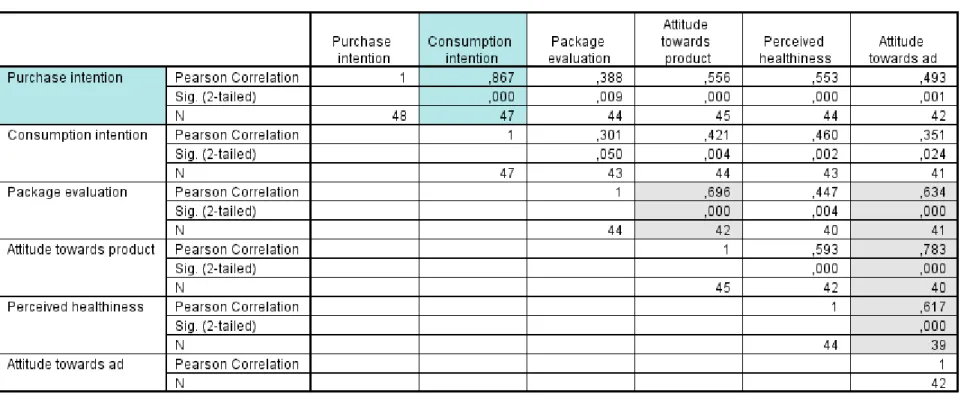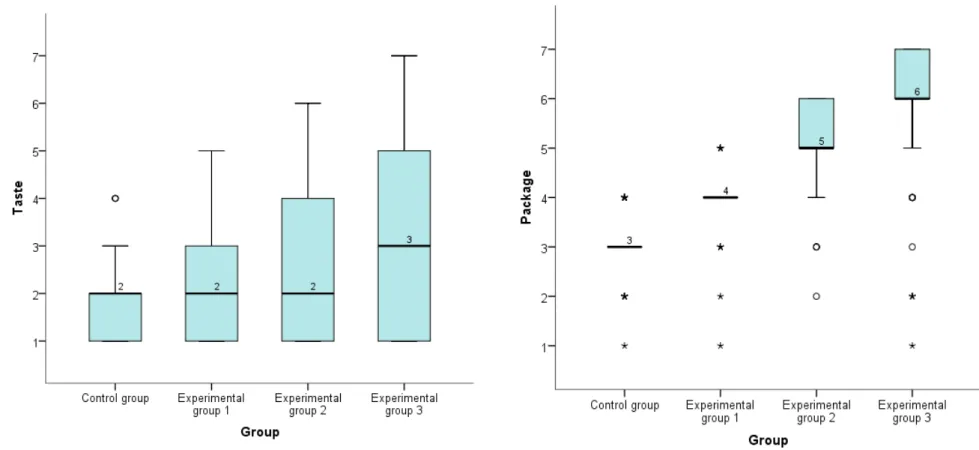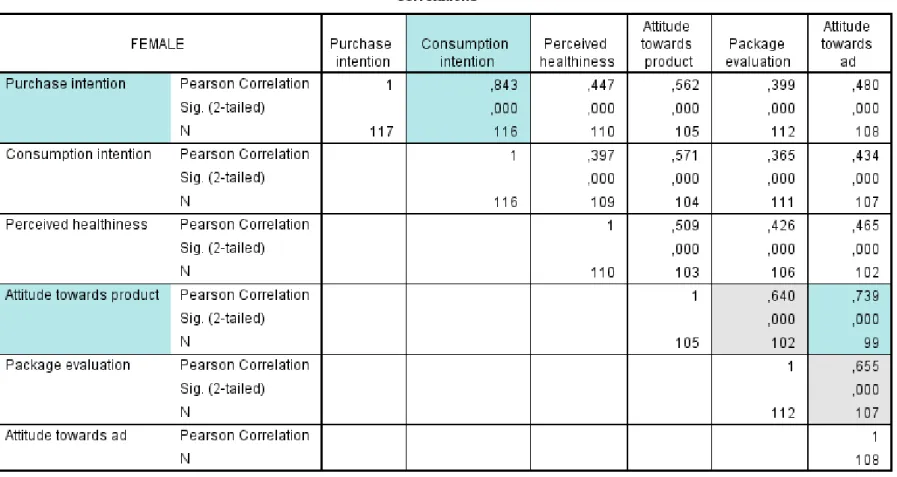A Work Project, presented as part of the requirements for the Award of a Masters Degree in Management from the NOVA – School of Business and Economics
How CSR claims in advertising affect children’s preferences and purchase
intentions
Carolina Perestrelo de Lemos #1147
A Project carried out on the Field Lab in Children Consumer Behaviour, under the supervision of Professor Luísa Agante
Abstract
This research project aims at studying the impact of the use of CSR claims in advertising towards children, by analyzing the impact of different executional cues of an advertisement created for this purpose. We measured the impact on the following independent variables: attitude towards the product and the advertisement, perceived healthiness of the product, package evaluation and purchase intention. An experiment was conducted with 193 children from 10 to 12 years old, controlling the individual variables related to environmental concern and previous social responsible behaviour of the child.
Results showed significant correlations between the independent variables analyzed, and a negative impact in attitude towards the product caused by the introduction of two CSR claims in the case of girls. Moreover, the high level of environmental concern and participation of children was confirmed. Based on these results, some lines of actions are suggested.
Table of contents
Introduction ... 3
Literature review and Research Questions ... 4
Methodology ... 8
Results ... 13
Discussion and Implications ... 21
Limitations and Further Research... 23
References ... 24
Appendixes ... 26 Introduction
Many companies use marketing strategies targeting children, due to the potential of building strong and lasting relationships with the target (Crane and Kasmi, 2010). There is also a big amount of research on advertising targeted at children, its effects on attitudes and behaviours of children and parents, and the recognition of its persuasive intent by children (McNeal, 1992).
At the same time, companies are increasing their investment in Corporate Social Responsibility (CSR) practices as a mean to increase their competitive advantage in the market. Research concerning these initiatives and its potential benefits is gaining more relevance and several studies confirmed the positive effects of CSR in key stakeholder groups (Sen, 2004). CSR strategies range from social to environmental subjects, assuming different forms, and the communication of those initiatives to key stakeholders’ groups is a crucial aspect to its effectiveness. Through schools, children are trained in and taught about environmental issues, and they engage in pro-environmental behaviours since early-ages.
proved to be successful. However, little research exists that addresses CSR claims effects on children.
The present study aims at researching the impact of CSR claims on children in advertising. It will approach advertising targeting children as a potential vehicle of communication of companies’ CSR practices. This study will use two common CSR claims used in advertising (local sourcing and CRM environmental actions) and will assess their impact on attitude and behaviour of children towards the product. It will also monitor gender effects and the potential differentiator aspect of two individual variables, environmental concern and previous social responsible behaviour of the child.
Literature review and Research Questions Children and Advertising
Children have huge potential as consumers since they are three markets in one: a primary market, due to the products purchased with pocket money, an influence market over their parents, and future market since they will be adult consumers in the future (McNeal, 1992). Therefore, children are often the target of campaigns aiming at creating brand loyalty since an early age (Moore et al. 2002).
understanding of its persuasive intent. However, this understanding might not be present when forming judgments(Moore, 2004).
CSR
Several definitions emerged concerning the concept of CSR. CSR can be described as a set of practices that improve the workplace and benefit society in ways that go above and beyond what companies are legally required to do. The European Commission (2010) defines CSR as ‘‘a concept whereby companies integrate social and environmental concerns in their business operations and in their interaction with their stakeholders on a voluntary basis.’’ More companies than ever are engaging in CSR initiatives such as cause-related marketing, corporate philanthropy, minority support programs and socially responsible employment and manufacturing practices (Bhattacharya and Sen, 2004).
The investment in CSR activities is due to its potential influence on consumers’ attitudes and behaviours, to its strategic role and differentiator element. In fact, the benefits of CSR initiatives have been assessed by several studies. For example, Luo and Bhattacharya (2006) found that CSR increases customer satisfaction, which in turn leads to positive financial returns. According to Brønn and Vrioni (2001), only a consistent, credible contribution to a cause can build brand image and brand equity. The communication of CSR policy is a crucial component of the equation, and must be handled carefully since it can bring benefits to the company but may also influence consumers’ skepticism.
social cause when customers engage in a purchase (Nan and Heo, 2007). This way, by supporting a social cause, a company can achieve its marketing objectives through CRM. Most CSR activities are targeted at adults, but the growth of the children market and the interest of marketers over this target, puts urgency upon research on this group, the question being whether they respond to the CSR stimulus in the same manner as adults.
Children and environmental concern
Environmental issues are a growing concern in children’s everyday life, being taught at school through topics such as recycling. Thus, a certain degree of environmental concern is arising in children’s minds, and behaviours are changing. Schultz (2000) states that environmental concern refers to the affect associated with environmental problems. A study conducted by Strife (2012) on children found that 82% expressed environmental concern when asked about that subject. Moreover, Hicks and Holden (2007) found that many children are fearful and pessimistic about environmental issues. In a study conducted to children between 4 and 12 years old, Chaves et al. (2007) found that 30% of the sample had an interest in recycling and environment related themes. On the other hand, some companies face charges on pollution and nature destruction as a consequence of their operations. This leads companies to engage in pro-environmental projects as part of its CSR strategy.
Local sourcing
as a way of boosting local development but also to generate positive effects on consumers’ attitude towards the product. In fact, Elliot and Cameron (1994) found a positive influence of the claims of local production on consumers’ product choice. Also, ‘origin is one product attribute thataffects the meanings consumers associate with food’ (Luomala, 2007). Dentoni et al. (2009) found that consumers used the fact that an apple was locally grown as a source of increased perceptions of sweetness, flavour and healthiness of that product. This way, a claim of local production will be introduced in this study to analyze if children’s attitude towards the product and perceived healthiness will be effected.
Purpose of the study
According to Hoeffler and Keller (2002), an important aspect related to the development of cause-related marketing campaigns is the selection of a cause that resonates with customers. Bhattacharya et al. (2010) explain this aspect with the stakeholders’ motivation to process CSR information. Moreover, Petty et al. (1981) showed that information perceived as self-relevant will trigger voluntary attention. Drumwright (1996) supports this view by finding a positive relationship between the affinity or attitudes held towards a cause and the perceived likelihood of the campaign’s success. Moreover, like previously mentioned, CSR communication is a crucial aspect of the strategy effectiveness.
product and the ad) and behaviour (consumption and purchase intention). Furthermore, two moderators will be introduced, in line with the CSR components that will be highlighted through the advertisement: environmental concern and previous social responsible behaviour. This exploratory study will answer the following research questions:
RQ1: What are the most significant correlations among the different variables analyzed? RQ2: Are there any significant differences in children’s attitudes and behaviours towards the product and ad when a CSR component is included in the ad? Are the correlations between the variables affected by a CSR claim?
RQ3: Is gender a differentiator aspect in children’s reaction to advertising?
RQ4: Are children actually concerned about the environment and engage in socially responsible behaviours? Do those factors have an influence on their attitudes and behaviours towards the ad and product when faced with an environment CSR claim?
Methodology
Legal and ethical requirements
The study was conducted with the required authorization from the schools and participating children’s parents. Moreover, children were given the option of not participating in this study, and the fact that there are no right or wrong answers was highlighted beforehand.
Sample
to analyze products according to more than one dimension at a time. Also, their knowledge of advertiser techniques and brands becomes much more sophisticated. Two schools in Lisbon participated in this study and 289 authorizations were sent to the parents. 194 children were allowed to participate, thus a response rate of 67%. One of the students was not present during the day of the study, which makes a sample of 193 children. The sample is composed of 60,6% females and 86% of children’s parents has some sort of degree. Students sampled were randomly and equally distributed by the four different groups.
Table 1 –Distribution of the sample by group and gender
Control Group Experimental Group I Experimental Group II Experimental Group III
Male Female Male Female Male Female Male Female
N 23 26 20 28 13 35 20 28
% within group 46,9% 53,1% 41,7% 58,3% 27,1% 72,9% 41,7% 58,3%
Children’s participation in this study was done through structured questionnaires, due to its quick administration and effectiveness in obtaining information about children’s attitudes (Greig et al., 2007). Questions were designed in 5-point scales, to guarantee the levels’ differentiation by children and also smiley faces were used, due to its visual appeal and to facilitate comprehension (Greig et al. 2007; McNeal, 1992). Moreover, bias was reduced by assuring that all the answers were anonymous and informing children there were no right or wrong answers (Podsakoff et al., 2003).
Research design
Moreover, McNeal (1992) states that soft drinks can target children in the three markets they belong to, i.e. primary, influencer and future consumers.
For the purpose of this study, an unfamiliar brand was included in the advertisement, as a way of eliminating possible attitudes and preferences towards a known brand, which adds internal validity to the study. This way, the Brazilian orange juice brand ‘Su Fresh’ was selected, checking children’s familiarity with it in the questionnaire. This brand was chosen due to the appropriateness of its package and the information on it to this study and because the packaging was already in Portuguese. Children were assessed through a structured questionnaire, which was distributed and filled in class (Appendix B). A small questionnaire was sent to the parents, attached to the authorization letter, in order to gather information on social class and beverages consumption patterns.
The experiment was conducted by manipulating the independent variable, the CSR claims, as the executional cue of the advertising. The whole sample was divided in four homogeneous groups: a control group which would be subject to the ad without the CSR claim; an experimental group I who would be exposed to the CSR claim pertaining to local sourcing; an experimental group II exposed to the CSR claim about the CRM cause (a fictitious cause related to planting trees in one region in Portugal); and finally an experimental group III who would be exposed to an ad which included both CSR claims.
Procedure
control group (CG). The second version, showed to experimental group I (EGI), adds to
these words the claim ‘Orange from Algarve’. The second experimental group (EGII), besides the base advertisement, was presented with the claim ‘Su Fresh protects the environment. For every 1000 juices sold, we will plant a tree in Serra da Estrela’. This claim represents the CRM component of the advertisement. Finally, the third experimental group (EGIII) combines the messages of the control group and the two experimental groups.
Pre-test
In order to test the appropriateness of the advertisement created and the cause scenario, a pre-test divided in two parts was conducted with 10 children from 10 to 12 years old. The first part tested the credibility of the advertisement, and the attractiveness of the product selected. Results showed that the advertisement previously designed was considered credible and the product attractive. The second part addressed the level of fit between the product and the cause chosen for the CRM component, in this case environment protection and planting of trees1. Results confirmed the high fit between the category of the product advertised and environmental issues. The second pre-test, conducted with the same children, addressed the final questionnaire. It confirmed its adequate length to children and two items were eliminated from one scale due to its lack of understanding by the target.
Measures
To measure purchase intention, children were asked about the probability of buying the product or asking their parents to buy, based on the study conducted by Phelps and
Hoy (1996). Moreover, consumption intention was measured through the probability of consuming the product.
The variable package evaluation was measured through a two-item 5-point semantic differential scale, based on the study made by Schoormans and Robben (1996), which was then adapted by Pires and Agante (2011). It is composed by ‘ugly-beautiful’ and ‘does not confer quality-confers quality’. Attitude towards the product was assessed through a three item, 5-point semantic differential scale, based on the study by Dixon et al. (2007) and adapted by Pires and Agante (2011). This scale contained the items ‘boring-fun’, ‘familiar-unfamiliar’ and ‘tastes bad-tastes good’. In order to measure perceived healthiness of the product, studies by Dixon et al. (2007) and Pires and Agante (2011) were once again used. This way, children were asked how healthy they think the juice is, through a 5-point scale (1- ‘very unhealthy’, 5- ‘very healthy’).
programs and engagementin social responsible behaviour, items from two previous studies (Youn and Kim 2008; Lange et al. 2007) were combined and adapted to the target. This way, a five-item, 5-point Likert scale was designed (called ‘previous participation’), including questions on recycling behaviour and volunteer experience for example. In order to assess the relative importance of each element in the choice of the product, children were asked to rank different aspects of the advertisement. Although no relevant previous studies applied this method, it was considered relevant to introduce it in our research. This way, the impact of the environmental or local claim could be assessed directly comparing it with the other advertisement’s components. The number of items to be classified varied according to the group, i.e. the advertisement shown to the child. Finally, and as a way to guarantee that all children would pay attention to the advertisement at the start of the questionnaire a question was introduced where children had to identify the elements that were present in the advertisement. This question was suggested by an expert researcher in consumer behaviour with CSR.
Results
To begin with, results confirmed the expected non-familiarity with the brand Su Fresh (85% of the children did not recognize the brand). This way, there was the guarantee that there were no previous attitudes towards the brand affecting children’s evaluation of the product. Also, we did not notice any difference in the children that knew the brand when compared to those who did not know it.
Purchase
intention Consumption intention Package evaluation
Attitude towards product Perceived healthiness Attitude towards ad
Pearson Correlation 1 ,842** ,433** ,569** ,373** ,414**
Sig. (2-tailed) ,000 ,000 ,000 ,000 ,000
N 193 192 185 176 179 178
Pearson Correlation 1 ,409** ,556** ,343** ,380**
Sig. (2-tailed) ,000 ,000 ,000 ,000
N 192 184 175 178 177
Pearson Correlation 1 ,649** ,371** ,631**
Sig. (2-tailed) ,000 ,000 ,000
N 172 173 177
Pearson Correlation 1 ,430** ,663**
Sig. (2-tailed) ,000 ,000
N 176 169 168
Pearson Correlation 1 ,427**
Sig. (2-tailed) ,000
N 179 168
Pearson Correlation 1
Sig. (2-tailed)
N 178
Attitude towards ad
**. Correlation is significant at the 0.01 level (2-tailed).
Table 3 - Highlight of the relevant correlations found
Purchase intention
Consumption intention
Package evaluation
Attitude towards product
Perceived healthiness
with the other two, thus was excluded from the analysis. (Alpha with 3-items= 0,511; Alpha with 2-items= 0,668). This might be due to the fact that some children did not understand what was being asked in this question. For each group of consistent items, a compound variable was then created, based on these items’ means.
Table 2- Cronbach alphas for each scale and from the original scales.
Scale Alpha Original Alpha
Package evaluation (Q4.1 + Q4.2) 0,629 0,71
Attitude towards product (Q5.1 + Q5.2) 0,668 0,72– 0,85
Attitude towards ad (Q7.1 + Q7.2 + Q7.3 + Q7.4) 0,792 0,94
Environmental concern (Q9.1 + Q9.2 + Q9.3) 0,806 -
Previous participation (Q10.1 + Q10.2 + Q10.3 + Q10.4 + Q10.5) 0,679 -
Research questions analysis2
RQ1: What are the most significant correlations among the different variables analyzed? The first step conducted in the SPSS analysis was the computation of the correlations between the variables from the questionnaire. As a starting point, a broad approach was taken, analyzing the entire sample with no distinctions among groups. Results confirmed some relations that are already suggested by previous research in advertising.
Thus, there was a significant correlation between purchase and consumption intention (R=0,842, p=0,000); attitude towards the ad and: attitude towards the product (R=
2
0,663, p=0,000); package evaluation (R=0,631, p=0,000). Moreover, it was found a positive relationship between attitude towards the product and: purchase intention (R= 0,569, p=0,000); consumption intention (R=0,556, p=0,000); package evaluation (R=0,649, p=0,000). The variable ‘perceived healthiness’ showed weak correlations with the other items analyzed (R<0,5). This way, we conclude that by developing advertising campaigns, marketers know they can influence the liking of the product and the evaluation of the packaging, which will have effects on their wish for purchasing and consuming it.
RQ2: Are there any significant differences in children’s attitudes and behaviours towards the ad and product when a CSR component is included in the ad? Are the correlations between the variables affected by a CSR claim?
In order to address the second research question, several T-tests were executed comparing each experimental group with the control group, in order to analyze any possible difference in the variables’ scores. All the performed tests were non significant (p>0,05) except when comparing CG with EGIII for the variable attitude towards the product. (p=0,032<0,05). Results suggest that the inclusion of two CSR claims decreases the attitude towards the product. The mean scores obtained for this variable and the two items that compose it are highlighted in Table 4 below.
Table 4– Mean scores for CG and EGIII for Attitude towards the product
This way, the group of children faced with the advertisement containing the two CSR claims believes that the juice will taste worse and is less fun than children in the control group. Therefore, our results suggest that CSR claims in advertising influence
Attitude towards the product ‘Tastes bad - Tastes good' ‘Boring - Fun'
Control Group 4,09 4,31 3,94
negatively children’s attitude towards the product, but only when its presence is noticed by children, i.e. when more than one claim is present in the advertisement. However, as we will later explain, this finding is only observed in the case of females.
This is in line with the synergy model presented by Del Vecchio (2002), since our results showed that the introduction of one CSR claim in the ad did not influence children’s perception about the product and its emotional benefit. On the other hand, when one additional claim is added, it becomes perceived by children who then integrate it in their attitude towards the product. These messages seem to weaken children’s perception of the product.
Furthermore, in order to assess the impact of local fruit claim on taste perception, a T-test was computed comparing CG with EGI for attitude towards the product (and the two items separately) and perceived healthiness but no significant differences were found. 3 Therefore, introducing a CSR claim related with the fact that local fruit was used in the production of the juice seems to not have an effect in taste perception of children and perceived healthiness.
In order to analyze the impact of CSR claims in children’s preferences, we computed the analysis regarding the question related to ranking a certain number of elements according to its importance for the choice of the product. By analyzing SPSS charts showing the distribution of the seven items that compose this question, it was found that the scores attributed to the four elements common to all sub-samples (taste, package, vitamins and advertisement itself) are similar across groups. This way, children’s attribution of importance is consistent across groups. In fact, the items ‘taste’ and ‘vitamins’ were preferred by children in the four groups, receiving the majority of the
number 1 and 2 attributions (Figures 1 and 2 below). This finding is in line with the study conducted by Edwards and Hartwell (2002), who concluded that children in the same age range have ‘an appreciation of the term healthy eating and could relate this to what they should be consuming’. This way, children considered that the taste of the juice and its healthiness are the most important factors in the decision of buying or drinking the juice, despite the fact that a CSR claim was present or not in the ad.
On the other hand, by comparing each item’s mean score across groups, we found that the items ‘package’ and ‘advertisement’ were consistently in the bottom of children’s attribution of importance.
Next, the same correlations analyzed in RQ1 were performed, taking into account the type of advertisement seen, in order to see if any significant differences would arise. The results showed a greater correlation between attitude towards the ad and the product for EGII (R=0,783; p =0,000), and the lowest value for EGIII (R=0,605; p=0,000). Also, package evaluation and attitude towards the ad are highly correlated in the last group (R=0,764; p=0,000) whereas control group shows the lowest value (R=0,508; p=0,000). Moreover, children in EGIII show the highest correlation in terms of attitude towards the product and consumption intention (R=0,730; p=0,000). As we saw in RQ1,
Figure 1 - Distribution of importance
the introduction of a CSR claim reduced the attitude towards the product, and therefore, if the correlation is higher, this means that it also has a bigger impact on consumption intention. On average, CG and EGI show lower correlations between the items, in comparison with experimental groups II and III. It is also visible that the type of claim introduced in experimental groups II and III (the CRM claim) uses a big part of the advertisement space, and we wonder if the ad clutter may have contributed to making these children more sensible.
RQ3: Is gender a differentiator aspect in children’s reaction to advertising?
In order to assess any differences related to gender, the same correlations previously explained were computed to each group, males and females. It was found that females show, on average, higher correlations between the variables, the higher differences being in the relationships between attitude towards the ad and the product (RF =0,739,
p= 0,000 vs. RM=0,539, p= 0,000) and between perceived healthiness and attitude
towards the product (RF=0,509, p=0,000 vs. RM=0,286, p=0,000). Therefore, we can
conclude that girls show a stronger relationship between the attitude held towards the ad seen and the evaluation of the product advertised. Also, perceived healthiness of the product has a greater impact on the attitude towards the product in the case of females. Several T-tests were also performed with the entire sample, using gender as a factor, to analyze any possible differences in the variables studied. We found a significant difference in terms of previous participation of children (p=0,003), females showing higher previous involvement in social responsible activities (xF= 4,31; xM= 4,03).
did not show significant differences by gender. Moreover, splitting the sample by gender, T-tests and Mann-Whitney tests4 were performed comparing CG with each EG, in order to further analyze the results found in RQ2. We found a significant difference between females in CG and EGIII in terms of attitude towards the product (T-test p=0,020), being the mean scores equal to 4,27 and 3,67, respectively. Females in the CG think the product will taste better (x=4,55) than those part of EGIII (x=3,96) and
that it is funnier (xCG= 3,85; xEGIII= 3,37). On the other hand, these differences were
not observed in males. Therefore, introducing two CSR claims in the ad will have a negative impact in girls’ evaluation of the product but no impact should occur in the case of boys. This finding has important implications for the execution of advertising campaigns targeted at girls.
To test any gender differences in attitude towards the product and perceived healthiness in the presence of a local label, a Mann-Whitney test was computed for CG and EGI. No significant differences were found between females of CG and EGI and the same was verified for males. This way, neither girls nor boys seem to perceive the juice as tastier or healthier if it is produced with locally sourced oranges.
Finally, to further explore the result found in RQ2, Spearman’s Rho tests by gender were conducted for EGIII, between attitude towards the product and the other variables. Higher correlations were found in the case of females when compared with males in that group.5 This way, girls faced with two CSR claims will show a higher correlation between the attitude towards the product and the other variables than boys. Therefore,
4
The test conducted was dependent on the result of Shapiro-Wilk Test for males/females in each group. 5
the negative effect of two CSR claims in attitude towards the product will highly influence girls’ purchase intention of the product.
RQ4: Are children actually concerned about the environment and engage in socially responsible behaviours? Do those factors have an influence on their attitudes and behaviours towards the ad and product when faced with an environment CSR claim? In order to understand the level of environmental concern and previous socially responsible behaviour of the children participating in the study, an analysis of frequencies was conducted. Results showed that children have a high level of environmental concern, since the variable mean is equal to 4,79 (on a scale 1 to 5). Moreover, the variable ‘previous participation’ shows similar results, being the mean equal to 4,2. However, it is important to mention that the last variable showed different results for the items that compose it. The items ‘previous volunteer experience’ and ‘community project participation’ (x=3,45; x=3,79 respectively) scored lower than the
remaining three items of the scale. Overall, we confirmed children’s high level of environmental concern and engagement in social responsible behaviours like recycling since early age.
the distributions of the individual items in relation to the other variables. We found significant differences for EGII in the following cases: males’ concern for environment (Q9.1) and their attitude towards the ad (p=0,049); females’ recycling behaviour (Q10.1) and consumption intention (p=0,047); attitude towards the product (p=0,042); package evaluation (p=0,036). An analysis of the Mean Rank values for those cases suggested that children who answered 5 in the individual variables tend to give a more positive evaluation to the other measures. The Chi-square tests performed for those scores were significant for the majority of the items6 and this tendency was confirmed by computing Crosstabs and analyzing the structure of these relationships. EGIII showed no significant differences by performing the initial test. This way, girls with a high level of recycling behaviour tend to evaluate the product and package more positively and show a higher probability of consuming it than girls with a lower level. Moreover, boys who show high level of environmental concern (who answered ‘of great concern to me’) seem to have a more positive attitude towards the ad than the ones who scored 4. These findings are expected to occur in the presence of one CSR claim only. However, these results were found in a small number of the items analyzed and no conclusions could be drawn regarding children with low levels of environmental concern and previous participation.
Discussion and Implications
This study addressed two intended effects of advertising on children: liking of the ad and the product (affective effects) and purchasing or requesting for the advertised brand (behavioural effects) (Rozendaal et al., 2011). The importance of the advertisement
6 Significant Chi-square tests (Exact Chi-square values):
1 – Males: ‘Ad stupid –great’ (0,036)
2 –Females: ‘Consumption intention’ (0,016) ; ‘Package quality’ (0,017); ‘Product Taste’ (0,002); ‘Product boring
elements and appeal to influence children’s attitude towards the product was confirmed, which will in turn have an impact on the likelihood that they will purchase or request it. Furthermore, if girls are the target, the execution of the advertisement gains more importance when compared with boys since stronger relationships exist between females’ attitude towards the ad and the product. Managers should pay special attention to this target since girls’ viewing of advertising will have a higher correlation with the probability of requesting it, when comparing with boys.
On the other hand, the taste and healthiness of a product should be highlighted in companies’ communication strategy, since these elements are highly valued by children and will attract their attention to the advertisement and product itself, thus increasing the likelihood of purchasing or requesting it.
Concerning companies’ CSR strategy, it is important to mention the high level of environmental concern of children from 10 to 12 years and girls’ higher engagement in recycling activities and charity giving, when compared with boys. This represents an opportunity for companies to promote this type of behaviours next to children from the concrete operational stage. Managers should include it in their strategic planning, since it is a subject that resonates with children, more so if the target is girls.
environmentally or socially related, will not have a significant impact in children’s attitudes and behaviours. More precisely, if managers’ goal is to increase children’s taste expectation and the product perceived healthiness, the introduction of a local sourcing claim should not be suggested since no significant difference will occur. We can then conclude that, when faced with an advertisement with a subtle CSR claim, i.e. one claim only, children do not seem to include this message as part of the product’s features or its emotional benefit. This way, if managers want to increase children’s liking of a product and their intent to purchase it, the introduction of CSR claims in the ad is not recommended.
Limitations and Further Research
Furthermore, the sample was composed exclusively by children from private schools, thus it would be interesting to conduct a research on a public school since a different result might be obtained, related with the social environment children are exposed to. Finally, further research should include older children, with more developed cognitive skills, since differences could arise with the introduction of CSR claims in advertising.
References
Becker-Olsen, K. L., Cudmore, B. A., Hill, R. P. 2006. “The impact of perceived corporate social
responsibility on consumer behavior”. Journal of Business Research, 59: 46– 53.
Bhattacharya, C. B., Sen, S. 2004. “Doing Better at Doing Good: When, Why, and How Consumers
Respond to Corporate Social Initiatives”. California Management Review, 47: 9-24.
Bhattacharya, C. B., Sen, S., Du, S. 2010. “Maximizing Business Returns to Corporate Social
Responsibility (CSR): The role of CSR Communication”. International Journal of Management Reviews, 12(1): 8-19.
Brønn, P. C., Vrioni, A. B. 2001. “Corporate social responsibility and cause-related marketing: an
overview”. International Journal of Advertising, 20: 207–222.
Chaves, M., Gervásio, E., Liz, C., Dutschke, G. 2007. Kids’Power - A Geração Net em Portugal.
Lisboa: Plátano Editora.
Crane, A., Kazmi, B. A. 2010. “Business and Children: Mapping Impacts, Managing Responsibilities”.
Journal of Business Ethics, 91: 567–586.
Del Vecchio, Gene. 2002. Creating Ever-Cool. A Marketer’s Guide to a Kid’s Heart. Louisiana: Pelican
Publishing Company, Inc.
Dentoni, D., Tonsor, G. T., Calantone, R. J., Peterson, H. C. 2009. “The Direct and Indirect Effects of
‘Locally Grown’ on Consumers’ Attitudes towards Agri-Food Products”. Agricultural and Resource Economics Review: 38(3): 384–396.
Dixon, H. G., Scully, M. L., Wakefield, M. A., White V. M., Crawford D. A. 2007. “The effects of
television advertisements for junk food versus nutritious food on children’s food attitudes and preferences”. Social Science & Medicine, 65: 1311-1323.
Drumwright, Minette, E. 1996. “Company Advertising With a Social Dimension: The Role of
Noneconomic Criteria”. Journal of Marketing, 60: 71–87.
Edwards, J. S. A., Hartwell, H. H. 2002. “Fruit and vegetables—attitudes and knowledge of primary
school children”. Journal of Human Nutrition and Dietetics, 15(5): 365–374.
Elliot, G. R., Cameron, R. C. 1994. “Consumer Perception of Product Quality and the Country-of-Origin
Effect”. Journal of International Marketing, 2(2): 49-62.
Elving, W. J. L. 2013. “Scepticism and corporate social responsibility communications: the influence of
fit and reputation”. Journal of Marketing Communications, 19(4): 277–292.
European Commission. 2010. Corporate social responsibility (CSR). Retrieved from
http://ec.europa.eu/enterprise/policies/sustainable-business/corporate-social-responsibility/index_en.htm
Hicks, D., Holden, C. 2007. “Remembering the future: What do children think?”. Environmental Education Research, 13: 501-512.
Hoeffler, S., Keller, K. L. 2002. “Building Brand Equity through Corporate Societal Marketing”. Journal
of Public Policy & Marketing. 21(1): 78-89.
John, D. R. 1999. “Consumer Socialization of Children: A Retrospective Look at Twenty-Five Years of
Research”. Journal of Consumer Research, 26(3): 183-213.
Lange, P. A. M. V., Bekkers, R., Schuyt, T. N. M., Vugt, M. V. 2007. “From Games to Giving: Social
Value Orientation Predicts Donations to Noble Causes”. Basic and Applied Social Psychology, 29(4): 375-384.
Luomala, H. T. 2007. “Exploring the role of food origin as a source of meanings for consumers and as a
determinant of consumers' actual food choices”.Journal of Business Research, 60: 122–129.
McNeal, J. U. 1992. Kids as Customers: A Handbook of Marketing to Children. Lexington Books.
Mohr, L. A., Eroglu, D., Ellen, P. S. 1998. “The Development and Testing of a Measure of Skepticism Toward Environmental Claims in Marketers’ Communications”. The Journal of Consumer Affairs, 32(1).
Moore, E. S., Wilkie, W. L., Lutz, R. J. 2002. “Passing the Torch: Intergenerational Influences as a Source of Brand Equity”. Journal of Marketing, 66: 17–37.
Moore, E. S. 2004. “Children and the Changing World of Advertising”. Journal of Business Ethics,
52(2): 161– 167.
Nan, X., Heo, K. 2007. “Consumer Responses to Corporate Social Responsibility (CSR) Initiatives. Examining the Role of Brand-Cause Fit in Cause-Related Marketing.” Journal of Advertising, 36(2): 63– 74.
Oates, C., Blades, M., Gunter, B. 2001. “Children and Television Advertising: When do they
Understand Persuasive Intent?”. Paper Presented at the Academy of Marketing, Cardiff, UK.
Öberseder, M., Schlegelmilch, B. B., Murphy, P. E. 2013. “CSR practices and consumer perceptions”.
Journal of Business Research, 66: 1839–1851.
Petty, R. E., Cacioppo, J. T., Goldman, R. 1981. “Personal involvement as a determinant of argument
based persuasion”. Journal of Personality and social Psychology, 41: 847-855.
Phelps, J. E., Hoy, M. G. 1996. “The Aad-Ab-PI Relationship in Children: The Impact of Brand
Familiarity and Measurement Timing”. Psychology & Marketing, 13(1): 77- 105.
Piaget, J., Inhelder, B. 1972. The Psychology of the Child. Basic Books.
Pires, C., Agante, L. 2011. “Encouraging children to eat more healthily: The influence of packaging”.
Journal of Consumer Behaviour, 10(3): 161-168.
Podsakoff, P. M., MacKenzie, S. B., Lee, J. 2003. “Common Method Biases in Behavioural Research: A
Critical Review of the Literature and Recommended Remedies”. Journal of Applied Psychology, 88(5): 879-903.
Rozendaal, E., Buijzen, M., Valkenburg, P. 2011. “Children’s understanding of advertiser’s persuasive
tactics’. International Journal of Advertising, 30(2): 329-350.
Schoormans J. P. L., RobbenH. S. J. 1996. “The effect of new package design on product attention,
categorization and evaluation”. Journal of Economic Psychology, 18(2-3): 271-287.
Schultz, P. W. 2000. “Empathizing with nature: The effects of perspective taking on concern for
environmental issues”. Journal of Social Issues, 56: 391-406.
Strife, S. J. 2012. “Children’s Environmental Concerns: Expressing Ecophobia”. The Journal of
Environmental Education, 43(1): 37–54.
Youn, S., Kim, H. 2008. “Antecedents of Consumer Attitudes toward Cause-Related Marketing”.
Control Group
This advertisement contains the base message, present in the other three, based on real juice ads. Messages: New/Vitamins rich/Refreshing flavour.
Experimental Group I
The message of this advertisement is added to the base advertisement and refers to the social Appendixes
Experimental Group II
The message of this advertisement is added to the base advertisement and refers to the environmental claim of the brand. It is composed by a general statement (Su Fresh protects the environment) and a CRM component (For every 1000 juices sold, Su Fresh will plant a tree in Serra da Estrela).
Experimental Group III
A Work Project, presented as part of the requirements for the Award of a Masters Degree in Management from the NOVA – School of Business and Economics
How CSR claims in advertising affect children’s preferences and purchase
intentions
Appendices Booklet
Carolina Perestrelo de Lemos #1147
A Project carried out on the Field Lab in Children Consumer Behaviour, under the supervision of Professor Luísa Agante
Table of contents
Appendix I ……….. 3
Appendix II ………..4
Appendix III ………. .17
Appendix I
Appendix II
Table 2.5 Descriptive analysis Control Group and Experimental Group 1
Appendix III
Table 3.4 Shapiro Wilk Test Normality Control Group Table 3. 5 Shapiro Wilk Test Normality Experimental Group 1
Table 3.8 T-test Control Group and Experimental Group 1 - Male
Table 3.10 T-test Control Group and Experimental Group 2 - Female
Table 3.19 Spearman’s rho for Experimental Group 3 by gender Attitude towards product Purchase intention Consumption intention Package evaluation Perceived healthiness Attitude towards ad Correlation
Coefficient 1,000 ,355 ,603
** ,304 -,175 ,436
Sig. (2-tailed) ,136 ,006 ,207 ,487 ,062
N 19 19 19 19 18 19
Attitude towards product Purchase intention Consumption intention Package evaluation Perceived healthiness Attitude towards ad Correlation
Coefficient 1,000 ,696
**
,695** ,711** ,346 ,669**
Sig. (2-tailed) ,000 ,000 ,000 ,084 ,000
N 26 26 26 26 26 25
FEMALE
Spearman's rho Attitude towards product
Correlations
MALE
Appendix IV
Table 4.1 Correlations between Environmental Concern and Previous Participation and the other variables for Experimental Group 2
Purchase intention Consumption
intention Package evaluation Attitude towards product Perceived healthiness Attitude towards ad Pearson
Correlation -,091 -,113 ,095 -,002 -,124 ,124
Sig. (2-tailed) ,582 ,498 ,571 ,992 ,472 ,458
N 39 38 38 37 36 38
Pearson
Correlation ,242 ,184 ,465
** ,397** ,224 ,275
Sig. (2-tailed) ,110 ,227 ,002 ,009 ,159 ,091
N 45 45 41 42 41 39
Previous participation
Correlations
EXPERIMENTAL GROUP 2
Environmental concern
Table 4.2 Correlations between Environmental Concern and Previous Participation and the other variables for Experimental Group 3
Purchase intention Consumption intention Package evaluation Attitude towards product Perceived healthiness Attitude towards ad Pearson Correlation
-,033 ,010 ,260 -,051 ,110 ,240
Sig. (2-tailed) ,827 ,947 ,081 ,746 ,481 ,112
N 46 46 46 43 43 45
Pearson Correlation
,155 ,262 ,120 ,158 -,075 ,149
Sig. (2-tailed) ,308 ,082 ,431 ,313 ,633 ,335
N 45 45 45 43 43 44
Previous participation
Correlations
EXPERIMENTAL GROUP 3
Significant Kruskal-Wallis Tests for found for Experimental Group 2, differentiating by gender
Significant Chi-Square tests found for the items of the variables that showed significant differences above, and descriptive Crosstabs
